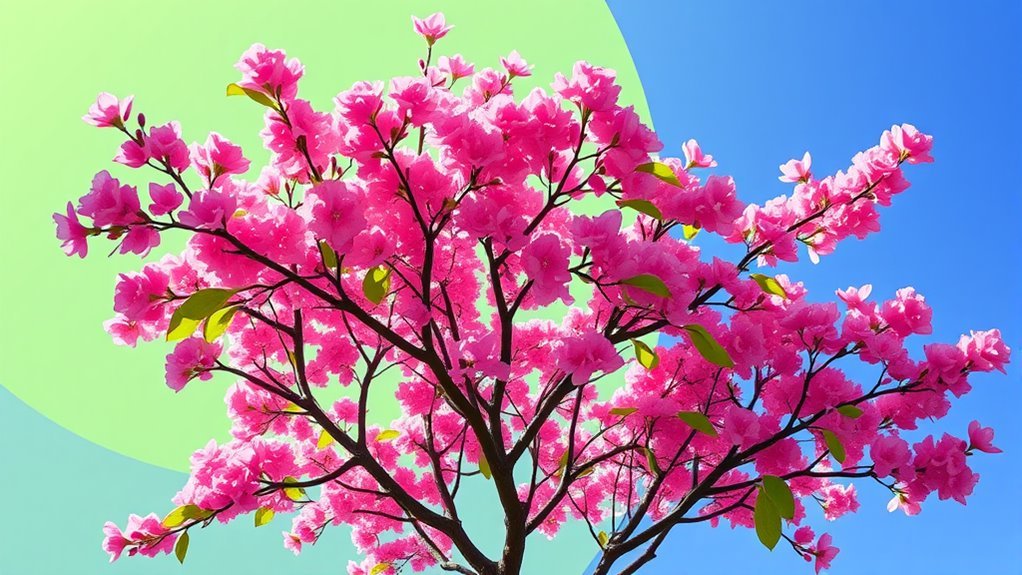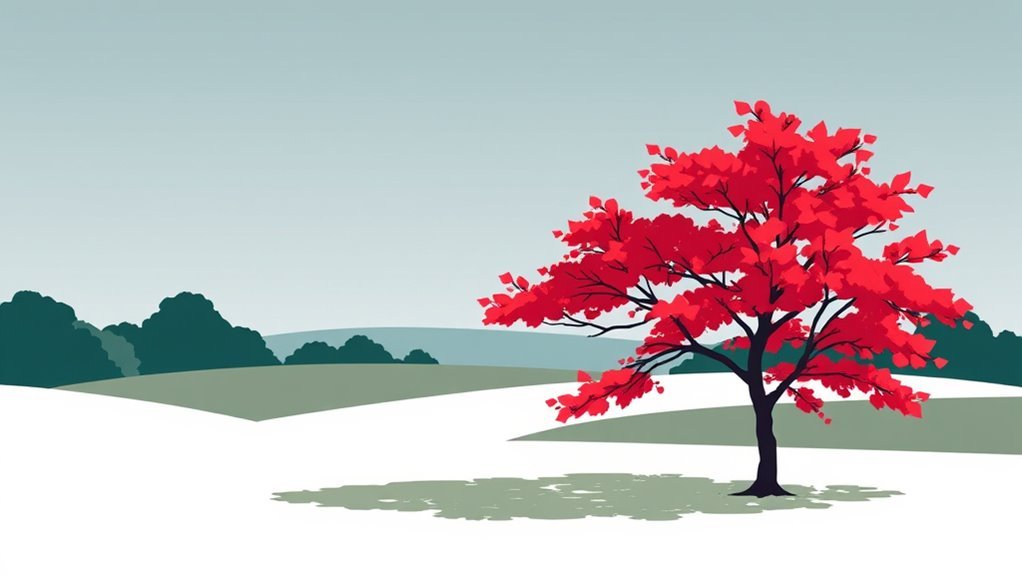Eastern Redbuds thrive in full sun to partial shade, requiring at least six hours of direct sunlight daily for peak growth. Prolonged shade can lead to stunted growth, sparse foliage, and reduced flowering, diminishing their ornamental value. While they can tolerate some shade, Eastern Redbuds are less suited for deep shade conditions. Understanding their light requirements and ideal growing conditions is essential for successful cultivation. Discover more about the best practices for growing these stunning trees.
Main Points
- Eastern Redbuds prefer full sun to partial shade, requiring at least six hours of direct sunlight daily for optimal growth.
- They can tolerate partial shade but may experience stunted growth and reduced flowering in prolonged shade.
- Prolonged shade can lead to leggy growth and sparse foliage, diminishing the tree's ornamental value.
- Ideal planting conditions include well-drained, loamy soil with a pH between 6.0 and 7.0 for best nutrient absorption.
- Companion plants like hostas and ferns thrive in similar low-light environments, enhancing the aesthetic of shaded gardens.
Understanding Eastern Redbud Light Requirements
Although Eastern Redbuds are known for their vibrant spring blossoms, their light requirements are essential for successful growth. These trees thrive best in full sun to partial shade, ideally receiving at least six hours of direct sunlight each day.
Sunlight plays a critical role in the overall health of the tree, influencing both foliage development and flowering potential. In ideal light conditions, Eastern Redbuds exhibit lush green leaves and a profusion of stunning pink flowers, attracting various pollinators.
However, inadequate light can lead to weaker growth and reduced flowering. When grown in too much shade, these trees may become leggy, with sparse foliage and fewer blossoms, compromising their aesthetic appeal.
Consequently, understanding the light requirements of Eastern Redbuds is essential for gardeners aiming for a robust and flourishing specimen in their environment. Providing the appropriate light conditions encourages not only healthy growth but also an impressive display of blooms each spring.
The Impact of Shade on Growth and Flowering

When Eastern Redbuds are planted in shaded areas, their growth and flowering potential can be greatly compromised.
These trees thrive in full sun, where they can access adequate light for photosynthesis. In shaded environments, the lack of sunlight inhibits their ability to produce energy, leading to stunted growth and reduced vigor. Consequently, the foliage may become sparse, and the structural integrity of the tree can weaken over time.
Additionally, flowering is considerably affected by shade. Eastern Redbuds typically bloom in early spring, but insufficient light can delay or diminish flower production.
The vibrant pink or purple blossoms that characterize this species may become fewer and less impressive, detracting from the tree's ornamental value.
In general, while Eastern Redbuds may survive in shaded conditions, their aesthetic and growth potential is prominently limited, leading to a generally less robust specimen.
Ideal Conditions for Eastern Redbuds
Eastern redbuds thrive under specific conditions that enhance their growth and flowering.
They require adequate sunlight, prefer well-drained soil, and have distinct watering needs that must be met for peak health.
Understanding these ideal conditions is essential for successful cultivation of this beautiful tree.
Sunlight Requirements
Sunlight acts as an essential factor in the growth and health of the Eastern Redbud, influencing its flowering and general vigor. This deciduous tree thrives best in full sun, which is defined as receiving at least six hours of direct sunlight daily.
Under ideal conditions, the Eastern Redbud displays vibrant pink blossoms in spring, contributing to its ornamental appeal. While it can tolerate partial shade, prolonged periods in low-light environments can hinder its growth, leading to sparse foliage and reduced flowering.
As a result, for those looking to nurture a healthy Eastern Redbud, ensuring adequate sunlight exposure is vital. A planting location that balances sun and shade can provide the necessary light, supporting its overall well-being and aesthetic qualities.
Soil Preferences
Healthy growth of the Eastern Redbud is closely tied to its soil preferences, which play a crucial role in its overall well-being.
This species thrives in well-draining soils, ideally loamy or sandy, which provide the necessary aeration for root development. A pH level between 6.0 and 7.0 is preferred, as it allows for optimal nutrient absorption.
While Eastern Redbuds can tolerate various soil types, they generally do not perform well in heavy clay or overly compacted soils, which can lead to root rot and other health issues.
Additionally, incorporating organic matter can improve soil structure and fertility, supporting robust growth.
Ultimately, understanding and meeting these soil requirements can greatly influence the health of Eastern Redbuds.
Watering Needs
Adequate watering is essential for the ideal growth of the Eastern Redbud, particularly in its early stages. This tree prefers consistent moisture, especially during its first few years after planting.
While Eastern Redbuds are relatively drought-tolerant once established, they thrive best with regular watering to maintain healthy growth and vibrant flowering. During dry spells, the soil should be kept evenly moist, avoiding both waterlogging and drought stress.
A good rule of thumb is to provide about an inch of water per week, either through rainfall or supplemental irrigation. Furthermore, mulching around the base can help retain soil moisture and regulate temperature, further supporting the tree's hydration needs.
Proper watering practices contribute greatly to the overall well-being and longevity of the Eastern Redbud.
Types of Shade: What You Need to Know

While many gardeners may assume that all shade is alike, understanding the different types of shade is essential for the successful growth of plants like the Eastern Redbud.
There are primarily three categories: full shade, partial shade, and dappled shade. Full shade occurs in areas that receive less than three hours of direct sunlight daily, often beneath dense tree canopies.
Partial shade, on the other hand, allows for four to six hours of sunlight, providing a balance that can benefit various plants.
Dappled shade features a mix of light and shadow, where sunlight filters through leaves, creating a soothing environment for many species, including the Eastern Redbud.
Recognizing these distinctions helps gardeners make informed decisions about planting and care, ensuring ideal conditions for the Eastern Redbud to thrive—even in less-than-ideal light conditions.
Understanding these nuances is vital for cultivating a healthy environment.
Tips for Planting Eastern Redbuds in Shady Areas

When planting Eastern Redbuds in shady areas, understanding ideal soil conditions and light requirements is essential.
These trees thrive in well-drained, loamy soil and can tolerate partial shade, but too much darkness may hinder their growth.
Careful consideration of these factors will help guarantee a healthy and vibrant tree.
Optimal Soil Conditions
Successful growth of Eastern Redbuds in shady areas relies heavily on prime soil conditions.
These trees thrive in well-draining, loamy soil that retains moisture without becoming waterlogged. The pH level should ideally range from slightly acidic to neutral, around 6.0 to 7.0, to support nutrient availability.
Incorporating organic matter, such as compost, can improve soil structure and fertility, providing essential nutrients for growth. Adequate drainage is critical, as stagnant water can lead to root rot and other diseases.
It is also beneficial to mulch around the base of the tree, which helps retain moisture and suppress weeds.
Light Requirements Explained
Eastern Redbuds can adjust to varying light conditions, but their growth in shady areas requires careful consideration of light exposure.
These trees thrive in partial shade, ideally receiving four to six hours of dappled sunlight daily. In deeper shade, growth may become sparse, and flowering can be greatly reduced.
To improve their chances of thriving, it is advisable to position them near the edge of wooded areas or under taller trees that filter sunlight.
Avoid planting in areas with complete shade, as this can lead to weak growth and increased susceptibility to pests and diseases.
Regular monitoring and adjustments to their environment can help guarantee that Eastern Redbuds maintain their vibrant foliage and beautiful blooms, even in less-than-ideal lighting conditions.
Companion Plants for Eastern Redbuds in Low Light
Although many flowering trees thrive in full sun, Eastern Redbuds can flourish in low-light conditions, making them a unique addition to shaded gardens.
To improve the aesthetic appeal of these trees, selecting compatible companion plants is essential. Perennials like hostas and ferns thrive in similar low-light environments, providing lush foliage that complements the delicate pink blossoms of the Redbud.
Shade-tolerant flowering plants such as astilbe and bleeding heart can add vibrant colors and textures beneath the tree. Additionally, ground covers like creeping thyme or ajuga can create a rich fabric at the base, preventing weeds while improving visual interest.
Incorporating shrubs like rhododendrons or azaleas can also provide structure and seasonal blooms, enriching the overall setting.
Together, these companion plants can create a harmonious, shaded garden that highlights the unique beauty of the Eastern Redbud.
Signs of Stress in Eastern Redbuds Due to Insufficient Light
When exposed to insufficient light, Eastern Redbuds may exhibit several signs of stress that indicate their struggle to thrive.
One of the most noticeable symptoms is leaf yellowing, particularly in older leaves, which may also drop prematurely. Additionally, the growth of Eastern Redbuds can become stunted, resulting in sparse foliage and elongated, leggy branches as the tree stretches toward available light.
Flowering may also be reduced, with fewer blooms appearing in the spring, diminishing the tree's ornamental appeal. Furthermore, the bark may reveal signs of damage or increased vulnerability to pests and diseases, as the tree's overall vitality declines.
In extreme cases, prolonged low light conditions can lead to dieback of branches or even the death of the tree. Recognizing these symptoms early can encourage timely intervention, such as relocating the tree to a sunnier spot or improving surrounding light conditions.
Common Questions
How Fast Do Eastern Redbuds Grow in Shaded Areas?
The growth rate of Eastern Redbuds in shaded areas tends to be slower compared to those in full sunlight. Typically, they can reach heights of 20 to 30 feet in ideal conditions over several years.
Can Eastern Redbuds Tolerate Wet Soil Conditions?
Eastern Redbuds can tolerate wet soil conditions to a certain extent, but prolonged saturation may lead to root rot. They thrive best in well-drained soils, highlighting the importance of proper drainage for ideal growth and health.
Do Eastern Redbuds Attract Wildlife in Shaded Locations?
Eastern redbuds are known to attract various wildlife, including pollinators like bees and butterflies, regardless of their location. Their vibrant blooms provide essential nectar, contributing to local biodiversity and enhancing the ecological health of shaded areas.
What Pests Commonly Affect Eastern Redbuds in Low Light?
Eastern Redbuds, often affected by pests such as aphids, spider mites, and scale insects, may experience increased vulnerability in low light conditions. These pests can cause considerable damage, impacting the tree's general health and importance.
Can Eastern Redbuds Survive in Urban Shade Environments?
Eastern Redbuds can adjust to urban shade environments, although their growth may be slower and flowering potentially diminished. They are resilient, often thriving in varied conditions if provided adequate soil and moisture.

